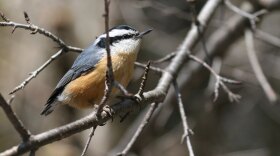-
With the leaves off the trees, winter can be a good time of the year to do some woodpecker watching.
-
If you feed the birds during the winter, you may notice some differences in the species visiting the feeders from year to year. Some species, such as chickadees, are consistent visitors. But other species, such as siskins, seem to vary considerably — and during some years they seem to show up en masse, indicating some sort of invasion or "irruption" — meaning a sudden change in the population density.
-
Audubon Dakota currently serves North and South Dakota — but soon, it will merge with the Nebraska office to become Audubon Great Plains. Main Street's Ashley Thornberg speaks with Executive Director for Audubon Great Plains Kristal Stoner.
-
No doubt many of you are familiar with Rachel Carson’s Silent Spring. Published in 1962 the book warned that continued widespread and indiscriminate use of pesticides could result in extensive ecological damage, including the death of songbirds, resulting in a “silent spring” when no songbirds would be heard. It is hard to imagine such a thing. But it looks as if we may be experiencing quieter springs.
-
It is that time of year. Labor Day is in the rearview mirror and thoughts are turning to fall. And fall in North Dakota often leads to thoughts of flocks of birds on their fall migration.
-
On this date, in 1965, a newspaper article reported the main characteristics of burrowing owls, noting that they are among the “few bird species to nest in burrows in the ground.”
-
I have been reading Theodore Roosevelt’s “Ranch Life and the Hunting Trail.” It is an interesting read about life in the North Dakota badlands in the 1880s. In chapter three, The Home Ranch, Roosevelt describes the quiet surrounding the ranch: “There are few sounds to break the stillness. From the upper branches of the cottonwood trees overhead, whose shimmering, tremulous leaves are hardly ever quiet, but if the wind stirs at all, rustle and quiver and sigh all day long, comes every now and then the soft, melancholy cooing of the mourning dove, whose voice always seems far away and expresses more than any other sound in nature the sadness of gentle, hopeless, never-ending grief.”
-
About 50 species of shorebird migrate through North America. Of those 50 species, about 36 pass on through, while a few stick around for the summer. They all take advantage of the lakes, wetlands, and the water pooled in farm fields.
-
We often hear birds singing or calling. But many times, the birds remain hidden amongst the vegetation, so identifying the bird is difficult. But now with the help of Merlin, a free app developed by the Cornell Lab of Ornithology, we can identify those birds. In this case it is a common yellowthroat, a yellow colored warbler with a black mask that is often heard while hidden in the vegetation on the margins of wetlands.
-
Duck nests have been a topic of discussion in the Prairie Public radio department recently. Director of Radio Bill Thomas and Producer Skip Wood were surprised to learn they each had a hen mallard nesting in their yard, but the location was a bit disconcerting. Except for a small pond on the Concordia College Campus, the nearest water (the Red River) is around 10-12 blocks away. So why does a duck nest so far from water?
Play Live Radio
Next Up:
0:00
0:00
Available On Air Stations









